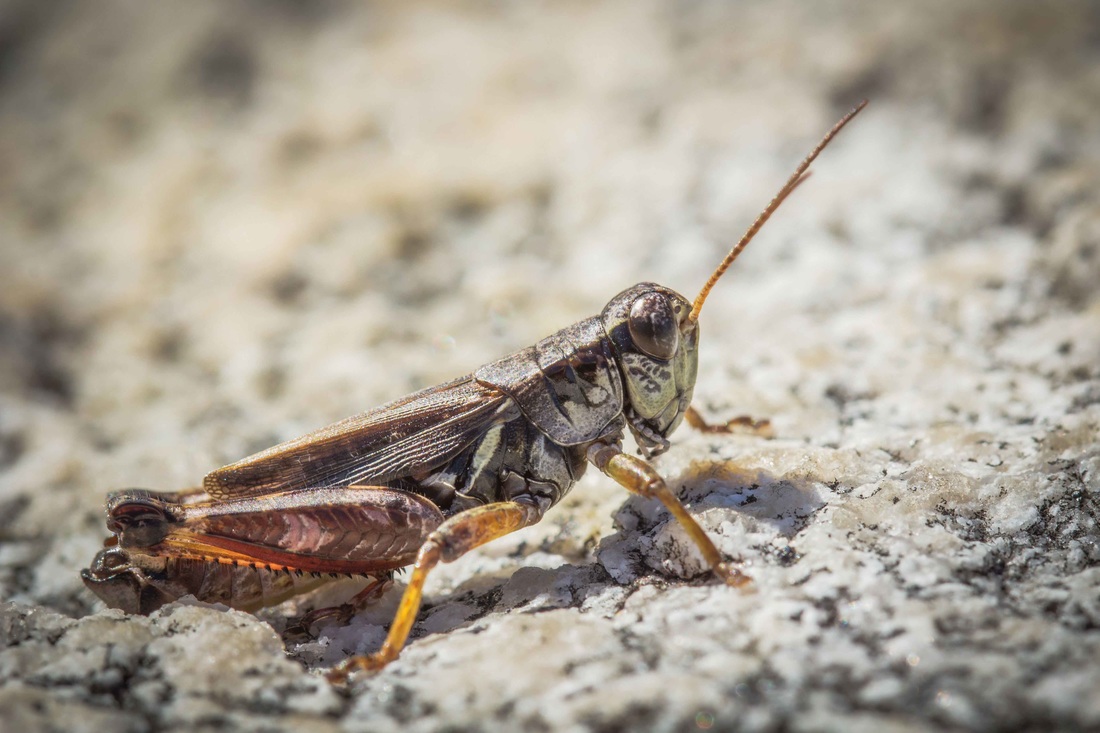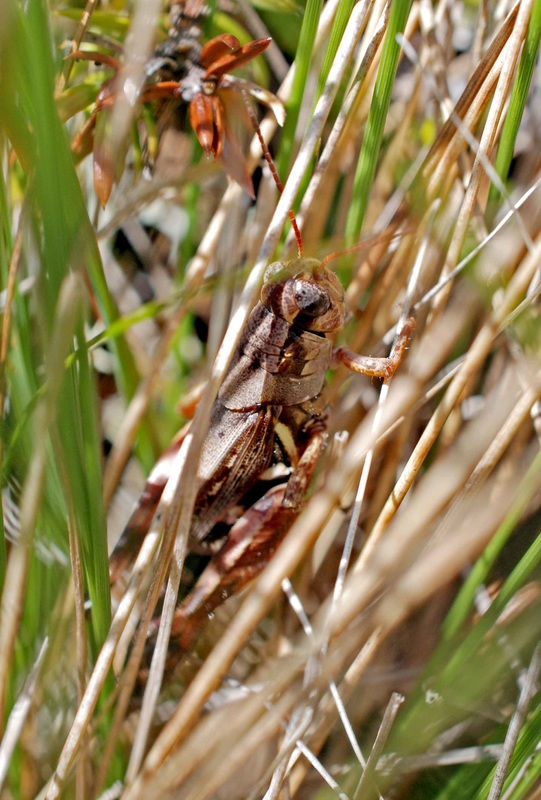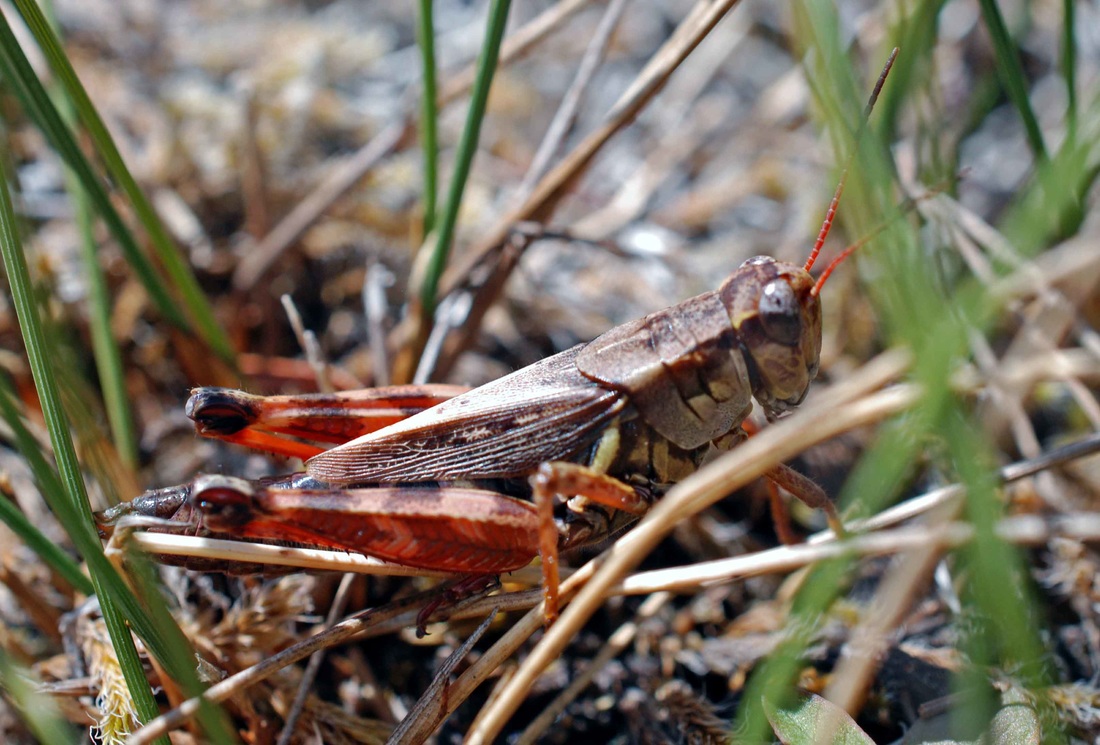Huckleberry grasshopper, huckleberry spur-throat grasshopper • Melanoplus fasciatus
Identification
The huckleberry grasshopper is approximately 2 cm long, with males (17-20 mm) smaller than females (20-25.5 mm). Its overall body colour is brown. The hind femurs are one of the most distinctive features of this species: they are usually marked with three dark bands, and have a red lower edge. The hind tibae are red as well (diagram). The face is quite flat - either completely vertical or slightly slanted - and has a dark band running from behind each eye and across part of the pronotum (section behind the head). The forewings (tegmina) are about twice the length of the pronotum. Proper identification requires examination of the male abdomen; see pages 12, 13, and 24 of Catling (2008) for further information. See BugGuide for more photos of this species.
Habitat & Range
The huckleberry grasshopper is a common boreal species, and is widespread throughout Canada and the northern United States. While its recorded range reaches the coast at Prince Rupert, the individuals pictured here were found on Calvert Island - well south of that range. This grasshopper is associated with heath plants, especially Vaccinium species (blueberries and huckleberries). It is found in open in dry and open woods, and among shrubbery in clearings and edge habitats.
iNaturalist
https://www.inaturalist.org/taxa/129133-Melanoplus-fasciatus
The huckleberry grasshopper is approximately 2 cm long, with males (17-20 mm) smaller than females (20-25.5 mm). Its overall body colour is brown. The hind femurs are one of the most distinctive features of this species: they are usually marked with three dark bands, and have a red lower edge. The hind tibae are red as well (diagram). The face is quite flat - either completely vertical or slightly slanted - and has a dark band running from behind each eye and across part of the pronotum (section behind the head). The forewings (tegmina) are about twice the length of the pronotum. Proper identification requires examination of the male abdomen; see pages 12, 13, and 24 of Catling (2008) for further information. See BugGuide for more photos of this species.
Habitat & Range
The huckleberry grasshopper is a common boreal species, and is widespread throughout Canada and the northern United States. While its recorded range reaches the coast at Prince Rupert, the individuals pictured here were found on Calvert Island - well south of that range. This grasshopper is associated with heath plants, especially Vaccinium species (blueberries and huckleberries). It is found in open in dry and open woods, and among shrubbery in clearings and edge habitats.
iNaturalist
https://www.inaturalist.org/taxa/129133-Melanoplus-fasciatus
References
B.C. Conservation Data Centre. (2015). Species Summary: Melanoplus fasciatus. B.C. Minist. of Environment. Accessed 03/09/2015.
Catling, P. M. (2008). Grasshoppers and related insects (Ulonata) of the Northwest Territories and adjacent regions. Environment and Natural Resources, GNWT, Yellowknife, NT.
Pfadt, R. Melanoplus fasciatus (Walker). Grasshoppers of Colorado. University of Wyoming Entomology. Accessed 03/09/2015.
Authors and editors of page
Kelly Fretwell, James Miskelly, and Brian Starzomski.
B.C. Conservation Data Centre. (2015). Species Summary: Melanoplus fasciatus. B.C. Minist. of Environment. Accessed 03/09/2015.
Catling, P. M. (2008). Grasshoppers and related insects (Ulonata) of the Northwest Territories and adjacent regions. Environment and Natural Resources, GNWT, Yellowknife, NT.
Pfadt, R. Melanoplus fasciatus (Walker). Grasshoppers of Colorado. University of Wyoming Entomology. Accessed 03/09/2015.
Authors and editors of page
Kelly Fretwell, James Miskelly, and Brian Starzomski.







